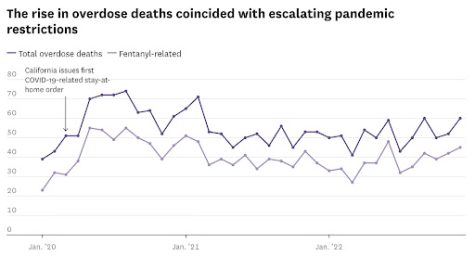Fentanyl? You Better Fend for Your All
After Mrs. Didier’s compelling speech at this month’s assembly, I’m sure we’ve all been left wondering: how bad can the crisis be to affect us? The answer to that question? There is no answer to take home, only precautions to heed so that it doesn’t extend to you.
February 19, 2023
On December 17, 2021, San Francisco Mayor London Breed declared an official state of emergency to address the glaringly-cataclysmic opioid epidemic. Our beloved Bay Area bears the brunt of the opioid epidemic: all nine Bay Area counties are now saturated with overwhelming numbers of opioid overdoses.
Opioids are a class of drugs that reduce severe pain, but in the context of drug and substance abuse, opioids are also a class of drugs that are misused for a distinctively addictive and physiological effect—for its “high.”

The most fatal and silent killer of them all? Fentanyl, a synthetic drug that can be up to 50 times stronger than heroin and 100 times stronger than morphine.
At the core of its medicinal and pharmaceutical roots, fentanyl is meant to be a powerful drug used to treat patients when all other opioids fail to alleviate conditions after severe surgeries. Yet, given the circumstances of the current epidemic, the potency of fentanyl is a double-edged sword. When opioid usage is driven by health and recovery, fentanyl proves to be effective medicine, but when fentanyl distribution is riddled with the illegal activity of ill-intentioned drug dealers, fentanyl proves to be a fatal weapon that can bring people to their destructive ends.
In fact, illicitly manufactured fentanyl (IMF) only takes $1,000 to produce one kilogram, a dosage which has the potential to kill 500,000 people. In its most common powdered form, it appears as over-the-counter drugs, eye drops, nasal sprays, candy, etc. “Fentapills”—leading to 79% of Gen Z drug deaths (higher than any other age group)—are unscrupulously made to imitate legal, pharmaceutical-grade opioids, leading users to be exposed to these highly dangerous substances infused in these counterfeit pills.
The Department of Justice (DOJ) cautions teens of the rise in rainbow fentanyl, a brightly-colored version of the synthetic opioid made to lure vulnerable teens and young adults into consumption. As the age demographics for death by fentanyl-related overdose gets progressively younger, it is abundantly clear that the drug is unbelievably (but unfortunately) too accessible.
When more people have died from fentanyl overdose than from COVID-19 in San Francisco, you would think that the city would take serious measures to mitigate the problem. Although San Francisco allocated $510 million to address the fentanyl crisis, the death toll has failed to decline.
Now, tackling the opioid crisis reveals itself to be a difficult feat. Given the current affairs of the world, the opioid crisis has extended to be a diplomatic and political issue beyond the borders of the United States of America; drug cartels from across the globe make achieving an ideological drug-less world more impossible. Smuggled across the U.S.-Mexico border in discrete but high-volume loads, fentanyl reserves are primarily sourced from Mexico. Just this month, President Joe Biden visited Mexico to seek the high-profile arrest of the notorious cartel leader Ovidio Guzman.
 Now, what can we, as the Mitty community, do to prevent this issue from hurting us? Although simplistic, our best and maybe only option is staying doubtful. Never take drugs, especially rainbow drugs, that weren’t sourced from an authentic, pharmaceutical dealer. Nevertheless, in the event of an overdose, Naloxone, a life-saving medication that can reverse an overdose from opioids, can be quickly administered through a quick nasal spray or injection.
Now, what can we, as the Mitty community, do to prevent this issue from hurting us? Although simplistic, our best and maybe only option is staying doubtful. Never take drugs, especially rainbow drugs, that weren’t sourced from an authentic, pharmaceutical dealer. Nevertheless, in the event of an overdose, Naloxone, a life-saving medication that can reverse an overdose from opioids, can be quickly administered through a quick nasal spray or injection.
Further, to protect our community, our school—cognizant of the looming threat fentanyl presents—has pledged the following efforts: providing educational programs to the entire Mitty community (i.e. faculty and staff, parents, and the student body); supplying Naloxone throughout campus for easy access; and requiring specific personnel (i.e. Administration, Mitty Health professionals, Campus Ministry, Athletics, Speech and Debate, and Performing Arts) to be trained in identifying and responding to fentanyl overdose. Training is also available on a voluntary basis to all faculty and staff.
Although talking openly about this crisis can be uncomfortable, we can and should advance knowing we are more well-informed. In an ideal world, access to fentanyl would be absent, but such idealism has yet to be achieved in our current world. For the sake of our youth, make smart decisions and be wary of the threats of fentanyl, for when it pertains to fentanyl, you better fend for your ayl (all).

